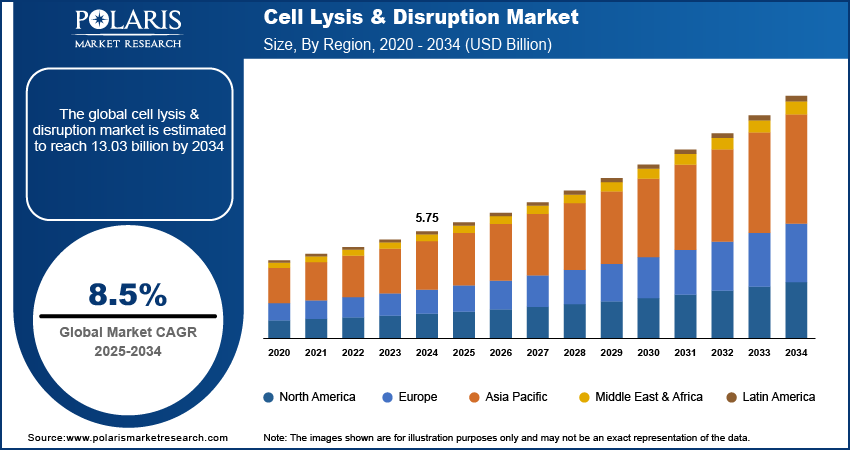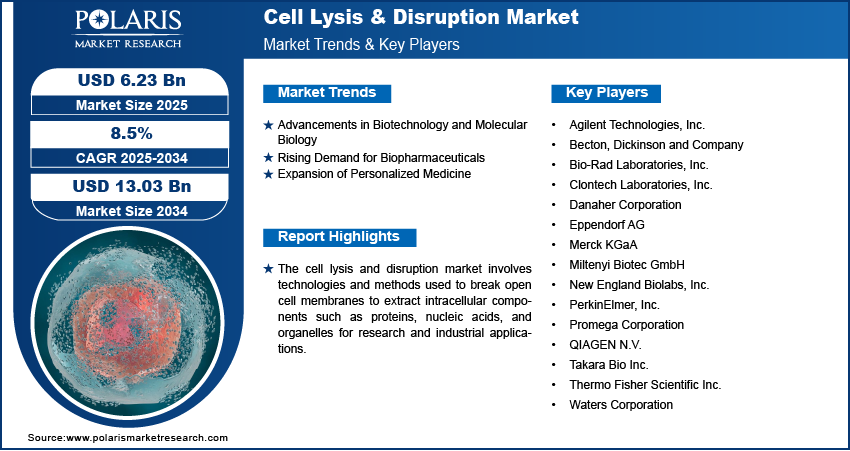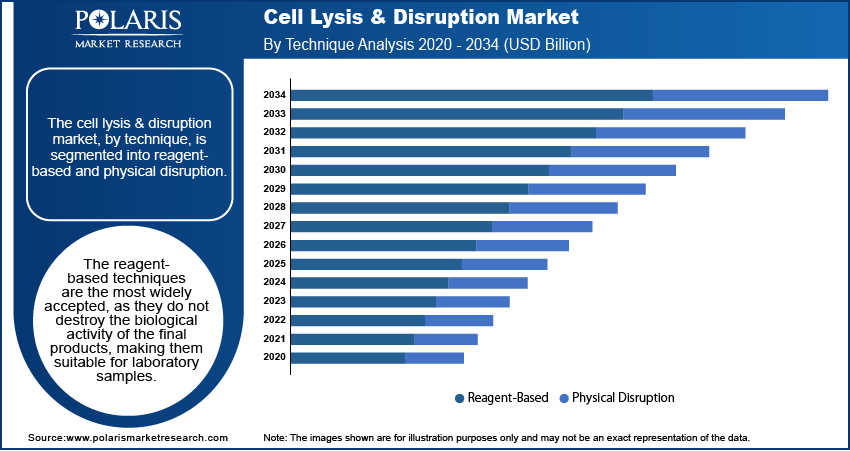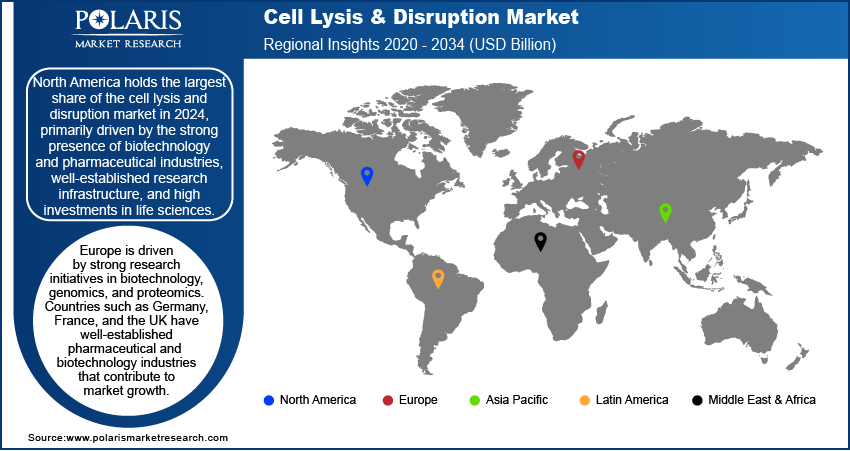
Cell Lysis & Disruption Market Size, Share, Trends, Industry Analysis Report
: By Technique (Reagent-Based and Physical Disruption), Application, End Use, Product, and Region (North America, Europe, Asia Pacific, Latin America, and Middle East & Africa) – Market Forecast, 2025–2034
- Published Date:Apr-2025
- Pages: 118
- Format: PDF
- Report ID: PM2090
- Base Year: 2024
- Historical Data: 2020-2023
Cell Lysis & Disruption Market Overview
The cell lysis & disruption market size was valued at USD 5.75 billion in 2024. The market is projected to grow from USD 6.23 billion in 2025 to USD 13.03 billion by 2034, exhibiting a CAGR of 8.5% during 2025–2034.
The cell lysis & disruption market growth is driven by the increasing demand for cell-based research, biopharmaceutical production, and advancements in molecular biology techniques. The rising adoption of recombinant protein production and monoclonal antibody development in drug discovery and therapeutics is contributing to market growth. Technological advancements in mechanical, chemical, and enzymatic lysis methods are improving process efficiency and yield, further supporting market expansion. The growing application of cell lysis in personalized medicine, genetic engineering, and diagnostic assays is also influencing market trends. Additionally, the increasing investments in biotechnology and life sciences research are expected to drive further development in cell lysis & disruption, creating suitable cell lysis & disruption market opportunities.

To Understand More About this Research: Request a Free Sample Report
Cell Lysis & Disruption Market Dynamics
Advancements in Biotechnology and Molecular Biology
The cell lysis and disruption market demand is significantly influenced by ongoing advancements in biotechnology and molecular biology. Innovations in techniques such as high-pressure homogenization and ultrasonic disruption have enhanced the efficiency of cell lysis processes, facilitating the extraction of high-quality intracellular components essential for research and therapeutic applications. These technological improvements have expanded the scope of applications, including protein isolation, nucleic acid extraction, and cell organelle isolation, thereby driving the market growth.
Rising Demand for Biopharmaceuticals
The increasing demand for biopharmaceuticals, including monoclonal antibodies, vaccines, and recombinant proteins, is a major driver of the cell lysis and disruption market development. Efficient cell lysis techniques are crucial for the production and purification of these biologics, as they enable the extraction of target molecules from various cell types. The growth of the biopharmaceutical industry necessitates advanced cell disruption methods to meet production and quality requirements, thereby propelling the market demand.
Expansion of Personalized Medicine
The expansion of personalized medicine has highlighted the need for precise and efficient cell lysis methods. Personalized treatments often require detailed molecular and genetic analyses, which depend on the effective disruption of cells to access intracellular materials. Therefore, as personalized medicine continues to evolve, the demand for specialized cell lysis techniques is expected to increase, contributing to cell lysis and disruption market expansion.

Cell Lysis & Disruption Market Segment Insights
Cell Lysis & Disruption Market Assessment by Technique
The cell lysis & disruption market, by technique, is segmented into reagent-based and physical disruption. In 2024, reagent-based techniques were the most widely accepted, as they do not destroy the biological activity of the final products, making them suitable for laboratory samples. The mild nature and suitability of this technique for laboratory applications further propelled the demand for reagent-based techniques in the cell lysis & disruption market.
Cell Lysis & Disruption Market Outlook by Application
The cell lysis & disruption market, by application, is segmented into protein isolation, downstream processing, cell organelle isolation, and nucleic acid isolation. The protein isolation application segment held the largest market share in 2024. This dominance is attributed to the extensive use of protein isolation in various fields, including proteomics, immunoprecipitation, and western blotting. The increasing demand for efficient techniques to prevent oxidation during mammalian protein extraction further supports the prominence of this segment.
The downstream processing segment is experiencing the highest growth rate within the market. This rapid expansion is driven by the rising demand for bioproducts such as vaccines, antibiotics, and antibodies. The recent emphasis on developing COVID-19 vaccines has notably accelerated the growth of downstream processing applications, highlighting the critical role of cell lysis and disruption techniques in biopharmaceutical manufacturing.
Cell Lysis & Disruption Market Evaluation by End Use
The cell lysis & disruption market, by end use, is segmented into academic & research institutes, hospitals & diagnostic labs, cell banks, and pharmaceuticals & biotechnology companies. The pharmaceutical & biotechnology companies segment held the largest market share in 2024. This is attributed to the extensive use of cell lysis techniques in drug discovery, development, and biopharmaceutical production. These companies rely on efficient cell disruption methods to extract intracellular components essential for creating therapeutic proteins, vaccines, and other biologics. The increasing demand for biopharmaceuticals further amplifies the need for advanced cell lysis technologies within pharmaceutical & biotechnology companies.
The academic and research institutes segment is experiencing the highest growth rate in the market. This surge is driven by high research activities in molecular biology, genomics, and proteomics, necessitating effective cell disruption methods for sample preparation and analysis. Government funding and private investments in life sciences research contribute to this growth as institutions seek advanced cell lysis techniques to facilitate their studies. The expanding focus on personalized medicine and genetic research within academic settings also propels the demand for efficient cell disruption solutions.
Cell Lysis & Disruption Market Assessment by Product
The cell lysis & disruption market, by product, is segmented into instruments, reagents & consumables, ionic detergent, nonionic detergent, and zwitterionic detergent. The reagents and consumables segment held the largest market share in 2024. This dominance is attributed to the widespread use of reagents in various applications, including protein extraction and nucleic acid isolation. Reagents offer specificity and efficiency in cell lysis processes, making them crucial in research and clinical settings. The continuous development of advanced reagents has further solidified the segment's leading position.
The instruments segment is experiencing the highest growth rate within the market. This surge is driven by the increasing adoption of sophisticated instruments such as homogenizers, sonicators, and microfluidizers, which enhance the efficiency and scalability of cell disruption processes. The demand for high-throughput and automated solutions in biopharmaceutical production and research laboratories contributes to the rapid expansion of the segment.

Cell Lysis & Disruption Market Regional Outlook
By region, the report provides cell lysis & disruption market insights into North America, Europe, Asia Pacific, Latin America, and the Middle East & Africa. North America dominated the cell lysis and disruption market share in 2024, primarily driven by the strong presence of the biotechnology and pharmaceutical industries, well-established research infrastructure, and high investments in life sciences. The region benefits from advanced healthcare facilities, increasing biopharmaceutical production, and significant funding for genomics and proteomics research. The presence of key market players and continuous technological advancements further support cell lysis & disruption market expansion in the region.
The Europe cell lysis & disruption market growth is driven by strong research initiatives in biotechnology, genomics, and proteomics. Countries such as Germany, France, and the UK have well-established pharmaceutical and biotechnology industries that contribute to market growth. Increased government funding for life sciences research and the presence of major academic institutions further support the demand for advanced cell lysis techniques in the region. Additionally, stringent regulatory frameworks in the region push companies to adopt high-quality reagents and automated instruments for efficient cell disruption processes. The growing focus on personalized medicine and biopharmaceutical production also plays a key role in regional market expansion.
The Asia Pacific cell lysis & disruption market is experiencing significant growth, supported by increasing investments in biopharmaceuticals, expanding research infrastructure, and government initiatives promoting life sciences. Countries such as China, India, and Japan are key contributors, with rising demand for proteomics and genomics research driving the need for advanced cell lysis technologies. The region's expanding biotechnology sector, along with the establishment of new pharmaceutical manufacturing facilities, is further fueling market adoption. Additionally, growing collaborations between international market players and regional research organizations are enhancing technological advancements and accessibility to high-quality cell lysis products.

Cell Lysis & Disruption Market – Key Players and Competitive Analysis Report
The cell lysis and disruption market comprises several active companies specializing in various techniques and products. These include Thermo Fisher Scientific Inc. Merck KGaA; QIAGEN N.V.; Bio-Rad Laboratories, Inc.; and Agilent Technologies, Inc. Additionally, companies such as Becton, Dickinson and Company; Danaher Corporation; and PerkinElmer, Inc. are notable participants in this sector. Other active entities include Promega Corporation, Miltenyi Biotec GmbH, and Takara Bio Inc. Furthermore, companies such as New England Biolabs, Inc.; Clontech Laboratories, Inc.; and Eppendorf AG contribute to the market landscape.
The companies offer a range of products and solutions tailored to various applications in the cell lysis and disruption market. For instance, Thermo Fisher Scientific Inc. provides reagents and instruments designed for efficient cell lysis, catering to both research and clinical laboratories. Merck KGaA offers a comprehensive portfolio of lysis buffers and enzymes, facilitating the effective extraction of cellular components. QIAGEN N.V. specializes in nucleic acid isolation kits, streamlining the process of DNA and RNA extraction from diverse cell types.
In terms of competitive insights, these companies differentiate themselves through innovation, product quality, and customer support. Bio-Rad Laboratories, Inc. emphasizes the development of user-friendly instruments that enhance laboratory workflows. Agilent Technologies, Inc. focuses on integrating advanced technologies into its products to improve efficiency and accuracy. Becton, Dickinson, and Company leverages its extensive experience in the life sciences sector to provide reliable solutions for cell analysis and processing. Collectively, these companies contribute to the advancement of cell lysis and disruption methodologies, supporting a wide array of scientific and medical research endeavors.
Thermo Fisher Scientific Inc. is a prominent company in the cell lysis and disruption market, offering a comprehensive range of products and services tailored for applications in life sciences research, biotechnology, and pharmaceutical development. The company's extensive portfolio includes reagents, instruments, and consumables designed to facilitate efficient cell lysis and disruption processes, thereby supporting various downstream applications such as protein isolation and nucleic acid extraction.
Merck KGaA, headquartered in Germany, is another key player in the market, providing a diverse range of solutions for cell lysis and disruption. The company's offerings encompass specialized reagents and kits aimed at ensuring effective cell disruption, catering to the needs of researchers and professionals in the fields of molecular biology and biopharmaceutical production.
List of Key Companies in Cell Lysis & Disruption Market
- Agilent Technologies, Inc.
- Becton, Dickinson and Company
- Bio-Rad Laboratories, Inc.
- Clontech Laboratories, Inc.
- Danaher Corporation
- Eppendorf AG
- Merck KGaA
- Miltenyi Biotec GmbH
- New England Biolabs, Inc.
- PerkinElmer, Inc.
- Promega Corporation
- QIAGEN N.V.
- Takara Bio Inc.
- Thermo Fisher Scientific Inc.
Cell Lysis & Disruption Industry Developments
- January 2021: Thermo Fisher Scientific, Inc. announced the acquisition of Henogen S.A., the viral vector manufacturing division of Novasep. This acquisition strengthened Thermo Fisher’s capabilities in gene and cell therapies and vaccines and enhanced its cell lysis and disruption business within the manufacturing workflow.
Cell Lysis & Disruption Market Segmentation
By Technique Outlook (Revenue – USD Billion, 2020–2034)
- Reagent-Based
- Physical Disruption
By Application Outlook (Revenue – USD Billion, 2020–2034)
- Protein Isolation
- Downstream Processing
- Cell organelle Isolation
- Nucleic acid Isolation
By End Use Outlook (Revenue – USD Billion, 2020–2034)
- Academic & Research Institutes
- Hospitals & Diagnostic Labs
- Cell Banks
- Pharmaceuticals & Biotechnology Companies
By Product Outlook (Revenue – USD Billion, 2020–2034)
- Instruments
- Reagents & Consumables
- Ionic Detergent
- Nonionic Detergent
- Zwitterionic Detergent
By Regional Outlook (Revenue – USD Billion, 2020–2034)
- North America
- US
- Canada
- Europe
- Germany
- France
- UK
- Italy
- Spain
- Netherlands
- Russia
- Rest of Europe
- Asia Pacific
- China
- Japan
- India
- Malaysia
- South Korea
- Indonesia
- Australia
- Vietnam
- Rest of Asia Pacific
- Middle East & Africa
- Saudi Arabia
- UAE
- Israel
- South Africa
- Rest of Middle East & Africa
- Latin America
- Mexico
- Brazil
- Argentina
- Rest of Latin America
Cell Lysis & Disruption Market Report Scope
|
Report Attributes |
Details |
|
Market Size in 2024 |
USD 5.75 billion |
|
Market Value in 2025 |
USD 6.23 billion |
|
Market Revenue Forecast by 2034 |
USD 13.03 billion |
|
CAGR |
8.5% from 2025 to 2034 |
|
Base Year |
2024 |
|
Historical Data |
2020–2023 |
|
Forecast Period |
2025–2034 |
|
Quantitative Units |
Revenue in USD billion and CAGR from 2025 to 2034 |
|
Report Coverage |
Revenue Forecast, Market Competitive Landscape, Growth Factors, and Trends |
|
Segments Covered |
|
|
Regional Scope |
|
|
Competitive Landscape |
|
|
Report Format |
|
|
Customization |
Report customization as per your requirements with respect to countries, regions, and segmentation. |
How is the report valuable for an organization?
Workflow/Innovation Strategy
The cell lysis & disruption market has been broadly segmented on the basis of technique, application, end use, and product. Moreover, the study provides the reader with a detailed understanding of the different segments at both the global and regional levels.
Growth/Marketing Strategy
The cell lysis and disruption market growth and marketing strategy focuses on product innovation, strategic collaborations, and geographic expansion. Companies invest in research and development to introduce advanced reagents and automated instruments that enhance efficiency and reproducibility. Collaborations with academic institutions and biopharmaceutical companies help expand product reach and drive adoption. Additionally, market participants focus on expanding distribution networks in emerging regions to tap into growing demand. Digital marketing, educational webinars, and targeted promotional campaigns are also employed to enhance product visibility and customer engagement.
FAQ's
The market size was valued at USD 5.75 billion in 2024 and is projected to grow to USD 13.03 billion by 2034.
The market is projected to register a CAGR of 8.5% during 2024–2034.
North America held the largest share of the market in 2024.
A few key players in the market are Thermo Fisher Scientific Inc.; Merck KGaA; QIAGEN N.V.; Bio-Rad Laboratories, Inc.; and Agilent Technologies, Inc. Additionally, companies such as Becton, Dickinson and Company; Danaher Corporation; and PerkinElmer, Inc. are notable participants in this sector.
The reagent-based lysis segment accounted for a larger share of the market in 2024.
Cell lysis and disruption refer to the process of breaking open cell membranes to release intracellular components such as proteins, nucleic acids, and organelles for further analysis or processing. This procedure is essential in various applications, including molecular biology, drug development, and biopharmaceutical production. The process can be achieved using different techniques, such as reagent-based chemical lysis, mechanical disruption methods such as homogenization and sonication, or enzymatic digestion.
A few key trends in the market are described below: Rising Demand for Biopharmaceuticals – Increasing production of biologics, monoclonal antibodies, and cell-based therapies is driving the need for efficient cell lysis techniques. Advancements in Automation and High-Throughput Technologies – Automated cell lysis instruments and high-throughput workflows are gaining adoption to improve efficiency and reproducibility. Increased Focus on Personalized Medicine – Growing interest in precision medicine is driving demand for efficient cell disruption methods for genomic and proteomic research. Expansion of Research in Cell-Based Studies – Increasing research in stem cells, gene therapy, and regenerative medicine is fueling the need for reliable cell lysis solutions.
A new company entering the market must focus on developing cost-effective and high-efficiency lysis solutions tailored for specific applications, such as single-cell analysis and gene therapy. Investing in automation and high-throughput systems can enhance workflow efficiency, addressing the growing demand for scalable bioprocessing solutions. Offering specialized reagent formulations for difficult-to-lyse cells and optimizing non-mechanical disruption techniques can provide a competitive advantage. Expanding into emerging markets, where biotechnology and pharmaceutical industries are rapidly growing, can help capture new customer segments. Additionally, ensuring compliance with regulatory standards and providing strong technical support will enhance credibility and market adoption.
